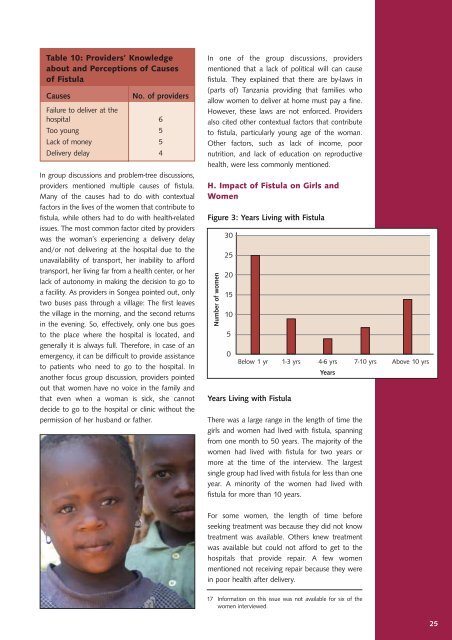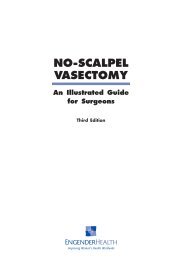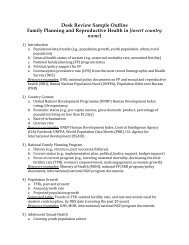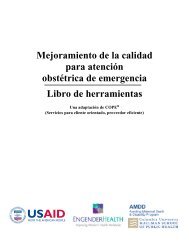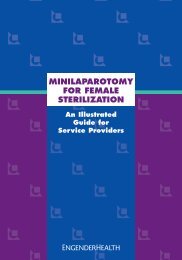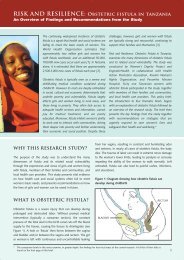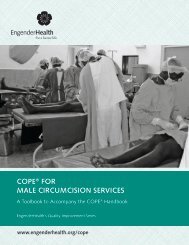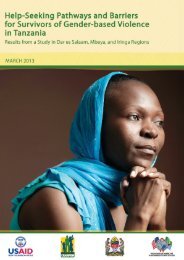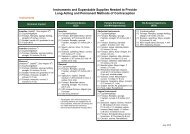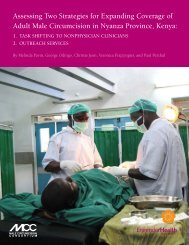Risk and Resilience: Obstetric Fistula in Tanzania - EngenderHealth
Risk and Resilience: Obstetric Fistula in Tanzania - EngenderHealth
Risk and Resilience: Obstetric Fistula in Tanzania - EngenderHealth
You also want an ePaper? Increase the reach of your titles
YUMPU automatically turns print PDFs into web optimized ePapers that Google loves.
Table 10: Providers’ Knowledge<br />
about <strong>and</strong> Perceptions of Causes<br />
of <strong>Fistula</strong><br />
Causes<br />
No. of providers<br />
Failure to deliver at the<br />
hospital 6<br />
Too young 5<br />
Lack of money 5<br />
Delivery delay 4<br />
In group discussions <strong>and</strong> problem-tree discussions,<br />
providers mentioned multiple causes of fistula.<br />
Many of the causes had to do with contextual<br />
factors <strong>in</strong> the lives of the women that contribute to<br />
fistula, while others had to do with health-related<br />
issues. The most common factor cited by providers<br />
was the woman’s experienc<strong>in</strong>g a delivery delay<br />
<strong>and</strong>/or not deliver<strong>in</strong>g at the hospital due to the<br />
unavailability of transport, her <strong>in</strong>ability to afford<br />
transport, her liv<strong>in</strong>g far from a health center, or her<br />
lack of autonomy <strong>in</strong> mak<strong>in</strong>g the decision to go to<br />
a facility. As providers <strong>in</strong> Songea po<strong>in</strong>ted out, only<br />
two buses pass through a village: The first leaves<br />
the village <strong>in</strong> the morn<strong>in</strong>g, <strong>and</strong> the second returns<br />
<strong>in</strong> the even<strong>in</strong>g. So, effectively, only one bus goes<br />
to the place where the hospital is located, <strong>and</strong><br />
generally it is always full. Therefore, <strong>in</strong> case of an<br />
emergency, it can be difficult to provide assistance<br />
to patients who need to go to the hospital. In<br />
another focus group discussion, providers po<strong>in</strong>ted<br />
out that women have no voice <strong>in</strong> the family <strong>and</strong><br />
that even when a woman is sick, she cannot<br />
decide to go to the hospital or cl<strong>in</strong>ic without the<br />
permission of her husb<strong>and</strong> or father.<br />
In one of the group discussions, providers<br />
mentioned that a lack of political will can cause<br />
fistula. They expla<strong>in</strong>ed that there are by-laws <strong>in</strong><br />
(parts of) <strong>Tanzania</strong> provid<strong>in</strong>g that families who<br />
allow women to deliver at home must pay a f<strong>in</strong>e.<br />
However, these laws are not enforced. Providers<br />
also cited other contextual factors that contribute<br />
to fistula, particularly young age of the woman.<br />
Other factors, such as lack of <strong>in</strong>come, poor<br />
nutrition, <strong>and</strong> lack of education on reproductive<br />
health, were less commonly mentioned.<br />
H. Impact of <strong>Fistula</strong> on Girls <strong>and</strong><br />
Women<br />
Figure 3: Years Liv<strong>in</strong>g with <strong>Fistula</strong><br />
Number of women<br />
30<br />
25<br />
20<br />
15<br />
10<br />
5<br />
0<br />
Below 1 yr 1-3 yrs 4-6 yrs 7-10 yrs Above 10 yrs<br />
Years<br />
Years Liv<strong>in</strong>g with <strong>Fistula</strong><br />
There was a large range <strong>in</strong> the length of time the<br />
girls <strong>and</strong> women had lived with fistula, spann<strong>in</strong>g<br />
from one month to 50 years. The majority of the<br />
women had lived with fistula for two years or<br />
more at the time of the <strong>in</strong>terview. The largest<br />
s<strong>in</strong>gle group had lived with fistula for less than one<br />
year. A m<strong>in</strong>ority of the women had lived with<br />
fistula for more than 10 years.<br />
For some women, the length of time before<br />
seek<strong>in</strong>g treatment was because they did not know<br />
treatment was available. Others knew treatment<br />
was available but could not afford to get to the<br />
hospitals that provide repair. A few women<br />
mentioned not receiv<strong>in</strong>g repair because they were<br />
<strong>in</strong> poor health after delivery.<br />
17 Information on this issue was not available for six of the<br />
women <strong>in</strong>terviewed.<br />
25


